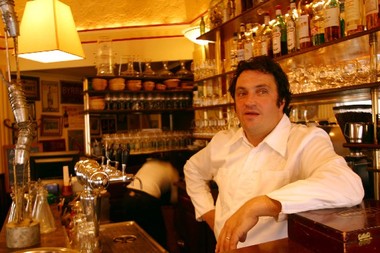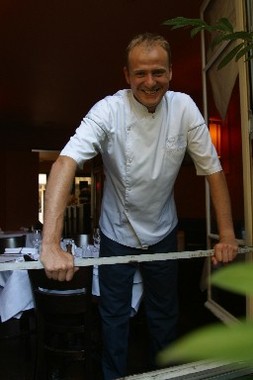Fine, French and ... Casual?
November 6, 2005 - The Santa Fe New Mexican

PARIS—This is fun to watch.
The Parisian dining scene is getting a long overdue shakeup that is leading to a new kind of restaurant. “Gastro bistros”—restaurants that combine Michelin restaurant-guide food quality with the conviviality and affordability of a French bistro—are beginning to bend or disregard the rules, creating a buzz that hasn’t been seen here since the end of nouvelle cuisine.
Two major recent events have erased the “trend” label from these upstart restaurants. First, Yves Camdeborde, the uncontested godfather of the movement, opened his second gastro bistro, Le Comptoir, in the heart of Paris. Camdeborde is credited with opening the first gastro bistro—La Regalade—in the 1990s in a far- flung corner of Paris better known for its proximity to decent Chinese food than for fine dining. After selling the restaurant to chef Bruno Doucet (who is carrying the torch nicely), Camdeborde opened Le Comptoir in May. The line has been out the door ever since.
The second event may be more worrying to the fine-dining establishment. After carrying Michelin’s ultra-elite three-star ranking (only a scant handful of other eateries across Europe hold the title) for 28 years at his restaurant, Lucas Carton, chef Alain Senderens traded in his stars and reopened as Senderens in September, reinventing his restaurant as an upscale gastro bistro.
French food has been in need of a shot in the arm. For years now, Spain has been stealing the food spotlight from France, that thievery led by superstar chef Ferran Adria and the otherworldly food at his restaurant, El Bulli, about two hours outside Barcelona.
Far less flashy, the gastro-bistro movement has been far slower to be recognized because its chefs’ goals are more subtle: slowly improving the classics while radically wrenching the cost/quality ratio in the diner’s favor. Most gastro bistros have prix fixe menus that cost about 30 euros (about $36), but a Michelin three-star can cost 10 times as much before the price of the meal’s wine is added to the bill.
For years, diners were forced to choose between spending their euros on expensive Michelin-rated dinners or the bistros’ near- everyday food. Now, the gastro bistros have stepped in, offering starred-food quality with bistro ambience and affordability.
“We’re trying to democratize fine dining,” says Thierry Blanqui, head chef at Le Beurre Noisette. Blanqui has been stereotyped as the quiet thinker of the group, and the shoe fits. He takes long pauses and looks away to think before answering most questions. Blanqui calls what they’re doing “revisited classic cuisine.”
 Chef Thierry Blanqui outside his restaurant, Le Beurre Noisette, in Paris. ‘Here, I have a huge amount of liberty,’ he says.
Chef Thierry Blanqui outside his restaurant, Le Beurre Noisette, in Paris. ‘Here, I have a huge amount of liberty,’ he says.He isn’t interested in recognition via stars. “Three stars? I don’t see it. There are too many constraints. Here, I have a huge amount of liberty, but when a (starred) restaurant works well, you have even more limitations.”
For 100 years, speculation has been rife over exactly what guidelines Michelin’s Red Guide (often simply referred to among French chefs and foodies as “the bible”) uses to determine its version of gastronomic perfection. Some claim that despite what Michelin says, even nonfood items such as silverware, tablecloths and proximity to lodging play into the ratings. The rare few who attain a third star are immediately launched into culinary-hall-of- fame status, but the financial implications are huge, and the pressure to keep the stars is incredibly intense.
Famed three-star chef Bernard Loiseau committed suicide in 2003 at the time his Michelin stars were rumored to be on a probationary status. Though Loiseau’s wife said the chef had greater problems that led to his suicide, the mere fact that many chefs saw this as a possibility was disturbing.
Liberation from the constraints of what bistros traditionally offer or the need to figure out Michelin’s cryptic desires is giving gastro-bistro chefs the freedom to do what they want.
The gastro-bistro gang doesn’t seem to miss the pressure. Asked about the advantages of freeing themselves from Michelin’s constraints, Blanqui just grins and says, “We don’t have rules.”
After a bit of reflection, he smiles again. “Our rules are that we want to do something simple that reveals the true character of the food. I want to put something special in the client’s mouth.”
Clear across town, Thierry Breton of Chez Michel couldn’t agree more. “My goal was never to have stars,” he says flatly. “I wanted quality, and if that’s all you need for stars, then sure. But stars aren’t only food and drink.” Michelin wants luxury in the establishment, he added.
As a rule, these new restaurants have traded a potentially snooty Michelin atmosphere for a warm bistro feel. A client is a lot more likely to find a waiter in a T-shirt than one in a jacket and tie.
“I’d rather develop my qualities (in the kitchen), where I’m more at ease,” says Breton. “I’d rather do what I like than to force myself. I know what one- to three-star restaurants are like, and that’s not what I’m after.”
How do they do it? The prix fixe menu is the key. By offering a limited number of choices and leaving standard bistro fare far behind, gastro-bistro chefs can focus on food quality and innovation. It’s not about serving the rarest product, but rather an effort to realize the highest potential of “everyday” products.
When up-and-coming French cooking magazine Regal asked for a recipe it could use for a recent issue, Camdemborde gave them one for sardines.
Sardines!
If ever there was a product at French food markets with “middle of the road” written all over it, the sardine would be a prime candidate. Camdemborde’s sardines, however, looked amazing.
Camdeborde banks on the quality of the product and his preparation. On one day in August, his small menu featured beef cheeks and pigs’ feet as well as one dish using ears and cheeks of suckling pig. On the same day at Le Beurre Noisette, Blanqui has an entire calf’s head bubbling away in a pot.
If you’re a first timer in the world of guts, glands and other stuff we don’t usually eat in the United States, these are the guys you want in charge of the initiation process.
“(To provide) quality, we have to stay simple,” says Camdeborde, who, unlike Blanqui, is neither quiet nor reflective. Looking a bit like a French version of Elvis, he speaks a mile a minute, frequently poking at your arm to emphasize a point.
“I’m hoping to continue to evolve French cuisine without being cheesy or has-been,” he says in French but throws in the last two words in thickly accented English.
“We don’t make recipes just for the sake of doing it,” he says, referring to some of the more curious stuff coming out of Spain.
“Plus we’re not going to charge 200 euros (about $241) for a plate because someone thought to put a slice of kiwi on a scallop,” he says, switching his point of reference to nouvelle cuisine. “The client is going to get tired of that.”
Though they occupy something that still remains a bit of a culinary outpost, these aren’t a bunch of glorified hamburger slingers with lots of chutzpah. Most of them trained with one another in three-star restaurants before setting off on their own.
For the time being, the movement is also small enough that among the chefs, everyone knows everyone, and they all help each other with recipes and rough patches. “We all took our own little boat together when we started out,” says Thierry Faucher at L’Os a Mo’lle, a stone’s throw from Blanqui’s Beurre Noisette.
As it turns out, they ride bikes, run marathons, play racquet sports and write cookbooks together. When they get the blues, they talk to each other for support. “We used to call each other all the time when we got going,” he says, then looks away, reconsiders and smiles. “We still do.”
Want more signs the gang is here to stay? Blanqui’s sous chef Pierre Petit is already dreaming of opening a gastro bistro in Bordeaux. Faucher has opened La Cave de l’Os a Mo’lle, offering a serve-yourself dream buffet at only 20 euros (about $24 and you should reserve ahead) and is about to open a French-style tapas bar.
Camdeborde, 41, is impressed with the next generation of chefs. “There are already kids out there who are 26 and are faster and know more than I did at that age.”
So what’s next for the godfather? “I’ve got this,” says Camdeborde gesturing around Le Comptoir. “I’m all set.”
Joe Ray is an expatriat living in Paris and a frequent contributor to The New Mexican.
IF YOU GO…
Le Comptoir
7-9, Carrefour de l’Odeon
75006 Paris
33 1 44 27 07 97
Le Beurre Noisette
68, rue Vasco-de-Gama
75015 Paris
33 1 48 56 82 49
L’Os Molle
3, rue Vasco-de-Gama
75015 Paris
33 1 45 57 27 27
Chez Michel
10 rue de Belzunce
75010 Paris
33 1 44 53 06 20